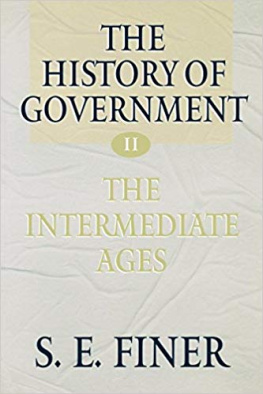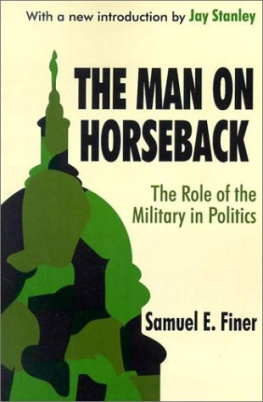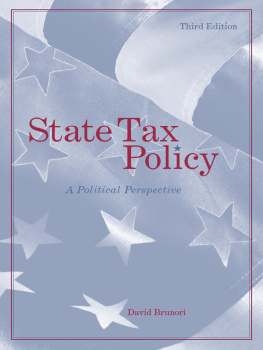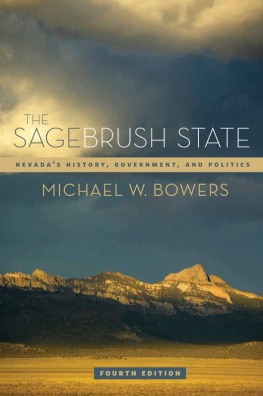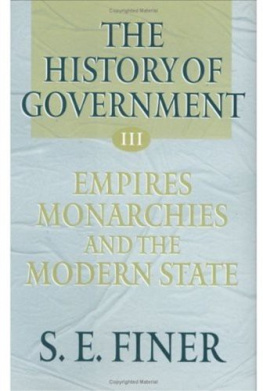Table of Contents

Page iii
The History of Government From the Earliest Times
Volume II
The Intermediate Ages
S. E. Finer
OXFORD
UNIVERSITY PRESS
Page iv
OXFORD
UNIVERSITY PRESS
Great Clarendon Street, Oxford OX2 6DP
Oxford University Press is a department of the University of Oxford.
It furthers the Universitys objective of excellence in research, scholarship,
and education by publishing worldwide in Oxford New York
Athens Auckland Bangkok Bogot Buenos Aires Calcutta
Cape Town Chennai Dar es Salaam Delhi Florence Hong Kong Istanbul
Karachi Kuala Lumpur Madrid Melbourne Mexico City Mumbai
Nairobi Paris So Paulo Singapore Taipei Tokyo Toronto Warsaw
and associated companies in Berlin Ibadan
Oxford is a trade mark of Oxford University Press
in the UK and in certain other countries
Published in the United States
by Oxford University Press Inc., New York
C. J. Finer 1997, 1999
The moral rights of the author have been asserted
Database right Oxford University Press (maker)
First published 1997
Reprinted 1998
First published as Paperback 1999
All rights reserved. No part of this publication may be reproduced,
stored in a retrieval system, or transmitted, in any form or by any means,
without the prior permission in writing of Oxford University Press,
or as expressly permitted by law, or under terms agreed with the appropriate
reprographics rights organisation. Enquiries concerning reproduction
outside the scope of the above should be sent to the Rights Department,
Oxford University Press, at the address above
You must not circulate this book in any other binding or cover
and you must impose this same condition on any acquiror
British Library Cataloguing in Publication Data
Data available
Library of Congress Cataloging in Publication Data
Data applied for
ISBN 0198206658
ISBN 0198207905 (pbk.)
Typeset by J&L Composition Ltd, Filey, North Yorkshire
Printed in Great Britain
on acidfree paper by
Biddles Ltd., Guildford and Kings Lynn
Page v
CONTENTS
Book III
Overview
1. The Intermediate Ages
2. The Political Relevance of the Historic Religions
3. New States for Old
4. Migrations and Invasions
5. The State System at the Close of the Middle Age
Part I. Eastern Europe and the Middle East
1. The Byzantine Empire ( c.1000)
1. Chronology
2. The Nature of the Byzantine Polity
3. The Territorial Framework
4. The Central Government
5. The Services
6. Appraisal
7. Conclusion: The Significance and Legacy of the Byzantine Polity
2. The Empire of the Caliphate ( c.900)
1. The Rise and Decline of the Empire of the Caliphs
2. Some Strengths and Weaknesses of the Empire
3. The Nature of the Polity: Comparisons and Contrasts
4. The Territorial Framework
5. The Caliph
6. The Central Government
7. The Services
8. Appraisal
9. Conclusion: The Nature and Limitations of the Caliphal Empire
Addendum 2a. A Note on Mamluk Egypt (12501517)
1. Significance and Nature of the Mamluk Polity
2. Mamluks: Generally
3. Egypt
4. Mamluk Rule
5. The BalanceSheet of Mamluk Rule
Page vi
Part II. China
3. The Tang Empire
1. Introductory: From Han to Sui
2. The Early Tang (618755)
3. The Later Tang (755874)
4. The End of the Tang (874907)
5. Conclusion
4. Government Under the Ming, 13681644
1. Ming Society and Economy
2. The Transit of the Ming
3. The Structure of Government
4. The Chinese Constitution
5. Paperwork and Paralysis
6. The GovernmentNotables Alliance
7. Maladministration
8. The Nature of the Regime
9. The Strengths and Weaknesses of the Ming Regime
Part III. Europe
5. The Feudal Background
1. The Dark Ages
2. Forces and Institutions in the High Middle Ages
3. Structures and Processes in the Medieval Regnum
6. The Regna
1. The Political Geography of Western and Middle Europe
2. The Development of the European Regna
3. The Feudal Kingdom of England
4. France: The Classical Feudal Kingdom
5. The Disintegration of the Kingdom of Germany
7. The Republican Alternative: Florence and Venice
1. The Thrust to Autonomy
2. Italia Insanguinata
3. The CityRepublic
4. The Government of Florence, c.1370
5. Venice: La Serenissima
6. The Legacy of the Medieval Republics
1019
8. Representative Assemblies
1024
1. The Great Political Invention of the Middle Ages
1024
2. The Clerical and the Secular Lineages of Representation
1029
Page vii
3. The Meaning of Representation
1032
4. The Characteristics of Assemblies
1036
5. Three Contrasting Representative Assemblies
1039
6. The Fate of the Representative Principle
1050
Bibliography
1052
Page 611
BOOK III
Page 613
Overview
1. The Intermediate Ages
It is conventional to divide European history into Classical Antiquity, Modernity, and a Middle Ages in between. Roughly speaking, the intermediate period spans the millennium AD 4501450. But while many historians might agree that this threefold periodization could be applied to, say, China or India and other places, the respective periods would fall between different dates in each different country. For instance, whereas the European Middle Ages conventionally run between AD 476
and 1453, the Middle Ages in China are usually placed in the 400 Years of Disunity from the crumbling of the Han in AD 190 to the coming of the Sui in AD 581.
For all that, in so far as the evolution of political forms is concerned, this millennium does in certain respects constitute a significant and distinctive stage, not just for Western Europe but globally. It saw three developments: the emergence in all civilized areas of what Bellah1 calls the Historic religions; the destruction of the old established state structures and the creation, after a time of troubles, of completely novel ones, in some areas; andfinallythe interruption of this same process of stateandcommunity building by wild incursions of uncivilized hordes from the Eurasian heartland.
2. The Political Relevance of the Historic Religions
These religionsneo-Zoroastrianism in Iran, Christianity in the Roman Empire, Islam in the Middle East, and even Buddhism in India and then China, shared the view that they and they alone worshipped the true God and/or professed the true way. They were exclusive, and in Europe and the Middle East as far as the Jaxartes and north India, rulers enforced them on their subjects under more or less severe sanctions for the first time in history.
These historic religions are to greater or lesser degree congregational, that is to say, they are communities of believers in which every individual has his own personal stake in his redemption, as pressing and as valid as that of any
1 R. N. Bellah, Sociologists at Work: Essays on the Craft of Social Research (Basic Books, New York, 1964).
Page 614
of his coreligionists and, equally, of his rulers. The religion was not a mere cult whose rituals were performed by special persons for the benefit of the people, but a matter of direct personal participation in divine worship. The individuals who professed the common beliefs formed what the Jews called the

